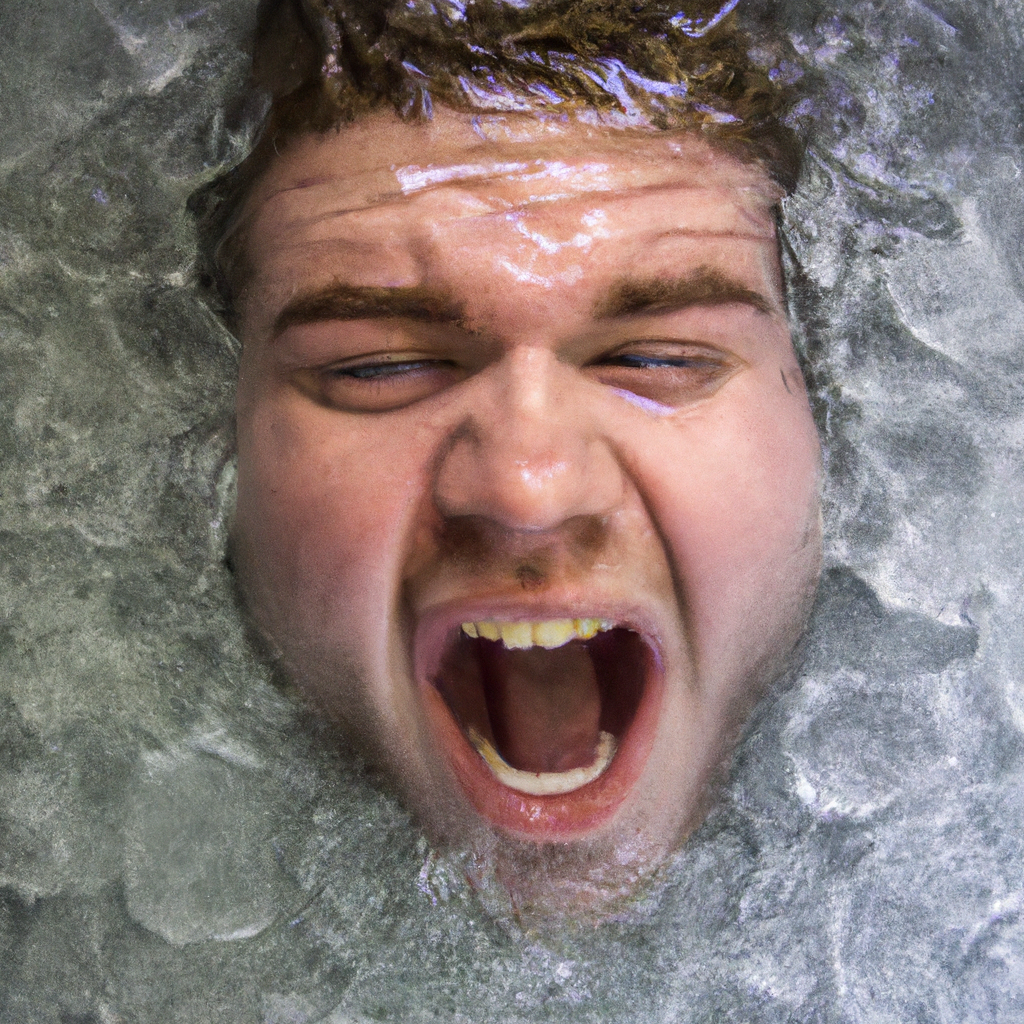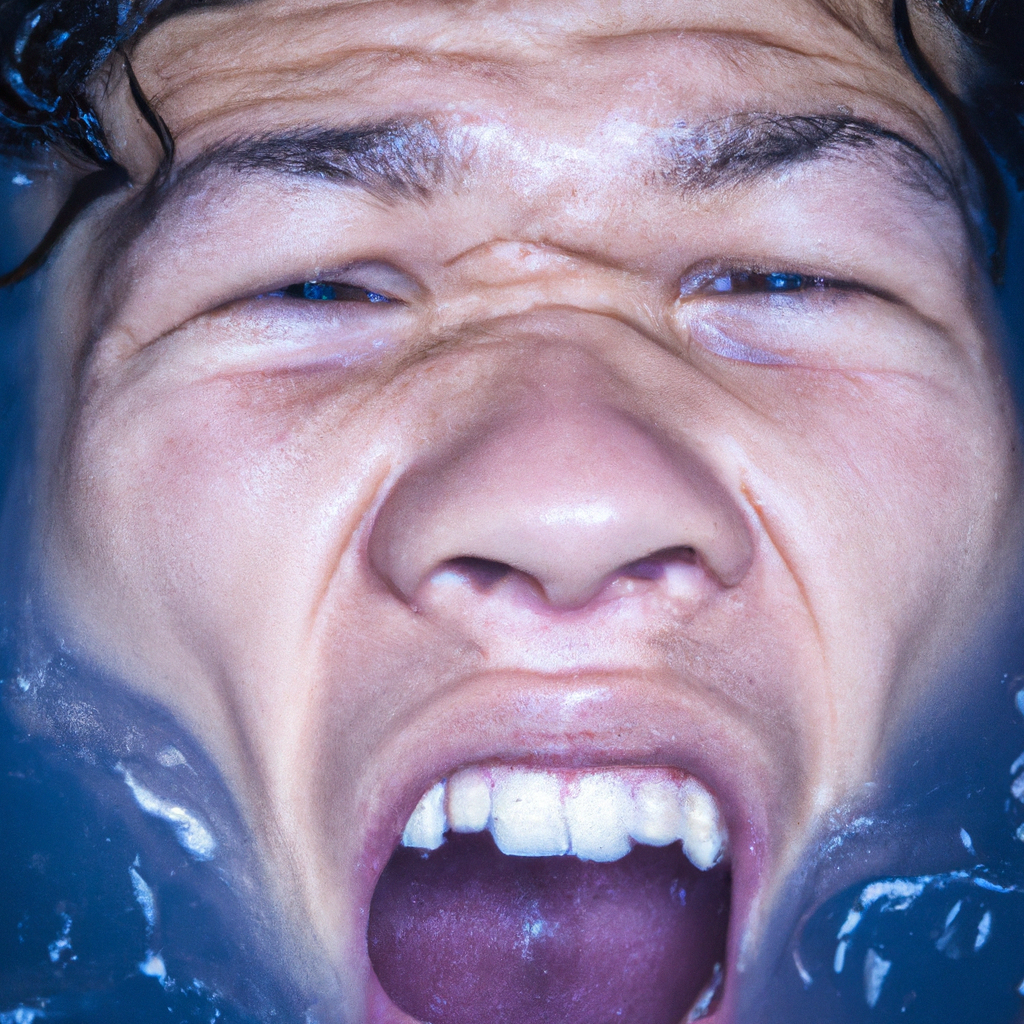If you’ve ever taken an ice bath, you know the intense sensation of your skin tingling and goosebumps appearing. But did you ever wonder why ice baths are often touted as a magical remedy? In this article, we’ll explore the science behind this chilly therapy and uncover the surprising truth about why ice baths work wonders for your body. Get ready to dive into the fascinating world of cold therapy and discover the secrets to rejuvenation and recovery that lie within the icy depths of an ice bath.

The Science Behind Goosebumps
Goosebumps, medically known as cutis anserina, are a fascinating physiological response that occurs when the tiny muscles at the base of each hair follicle contract, causing the hair to stand on end. This reaction is actually inherited from our evolutionary ancestors, serving as a survival mechanism when faced with threats or cold temperatures. In this article, we will delve into the science behind goosebumps and explore the various benefits and precautions associated with ice baths, a practice often associated with inducing goosebumps.
The Physiology of Goosebumps
When you experience strong emotions such as fear or excitement, or when you are exposed to cold temperatures, your autonomic nervous system triggers the release of adrenaline. This stress hormone causes the contraction of the tiny arrector pili muscles located at the base of each hair follicle. The contraction pulls on the hair follicles, causing the hairs to stand upright. This response, also known as piloerection, creates the bumpy appearance of the skin, hence the term “goosebumps.”
The Role of Nerves and Muscles
Goosebumps are controlled by the autonomic nervous system, which operates largely outside of our conscious control. When your body detects a threat or perceives cold temperatures, signals are sent through the sympathetic nervous system, triggering the release of adrenaline. This hormone acts on the arrector pili muscles, causing them to contract and create goosebumps. Interestingly, this response is not unique to humans; many animals, including mammals, exhibit the same reaction.
The Relationship with Temperature
While goosebumps can be triggered by various factors, including emotions, we commonly associate them with cold temperatures. When exposed to cold, our bodies instinctively attempt to warm up by contracting the muscles around the hair follicles and trapping a layer of air close to the skin’s surface, which acts as insulation. This response is essential for maintaining body temperature and preventing excessive heat loss in chilly environments. Thus, goosebumps serve as a reminder of our body’s remarkable ability to adapt and protect itself in different situations.
Benefits of Ice Baths
Ice baths, often used by athletes and individuals seeking enhanced recovery, have gained popularity due to their potential benefits. Let’s explore some of the advantages associated with this chilly practice.
Enhanced Recovery and Reduced Inflammation
One of the primary reasons athletes turn to ice baths is their potential to aid in recovery and reduce inflammation. When immersed in cold water, blood vessels constrict, decreasing blood flow to the muscles. This constriction helps reduce inflammation and swelling, which often occurs after intense physical activity or injury. Additionally, ice baths can assist in flushing out metabolic waste products and decreasing muscle soreness, enabling faster recovery from strenuous workouts.
Improved Athletic Performance
Ice baths may also have a positive impact on athletic performance. By lowering the body’s core temperature, ice baths can help combat heat exhaustion, which is common during intense physical exertion. The cooling effect of the cold water can act as a natural form of temperature regulation, allowing athletes to push their limits and prolong their exercise duration. Furthermore, ice baths have been found to improve muscular endurance and reduce fatigue, enhancing overall performance.
Boosted Mood and Mental Wellbeing
Beyond physical benefits, ice baths are believed to have a positive impact on mental health and overall wellbeing. Taking a dip in icy water stimulates the release of endorphins, the body’s natural mood-boosting chemicals. This surge of endorphins can promote feelings of relaxation, reduce stress, and even alleviate symptoms of depression. Many individuals find that the invigorating sensation of an ice bath provides mental clarity and a sense of rejuvenation, further enhancing their overall mood and mental wellbeing.

Cold Shock Proteins and Cryotherapy
Cold shock proteins, also known as CSPs, are a fascinating area of scientific research that has garnered attention in recent years. Let’s explore these proteins and how cryotherapy, which includes ice baths, can elicit their activation and potential benefits.
Understanding Cold Shock Proteins
Cold shock proteins are a specific class of proteins that are synthesized by the body in response to cold temperatures. These proteins play a crucial role in protecting cells from damage caused by low temperatures and other stressors. When exposed to cold, cells activate specific genes that produce cold shock proteins, which then aid in maintaining cell integrity and promoting survival. The activation of these proteins has been linked to various health benefits, such as improved immune function, increased stress resistance, and enhanced tissue repair.
Activation and Benefits of Cryotherapy
Cryotherapy, including ice baths, is a practice that involves exposing the body to extremely cold temperatures for a short period. This exposure to cold triggers a cascade of physiological responses, including the activation of cold shock proteins. By subjecting the body to a controlled cold stress, cryotherapy enthusiasts believe that it can potentially enhance immune function, increase circulation, reduce inflammation, and even promote weight loss. However, it is important to note that scientific research in this area is still ongoing, and the exact mechanisms and long-term effects of cryotherapy are not yet fully understood.
The Potential for Longevity
The activation of cold shock proteins through cryotherapy has also sparked speculation about their potential role in promoting longevity. Some studies have suggested that cold shock proteins may have anti-aging properties and can help protect against age-related diseases. Researchers continue to investigate the mechanisms through which these proteins operate and explore their potential applications in the field of longevity research. While the full extent of their benefits is still unclear, the study of cold shock proteins holds exciting possibilities for understanding the human body’s response to stress and its potential for extended healthspan.
Ice Baths: How to Do It Right
Embarking on an ice bath can be a daunting experience for newcomers. However, following the proper techniques and guidelines can ensure a safe and effective ice bath session. Here’s how to do it right:
Gradual Exposure and Temperature Control
When attempting an ice bath, it’s important to start gradually to give your body time to adjust. Begin by filling a tub with cold water and gradually add ice to achieve the desired temperature. It is recommended to aim for temperatures between 50 to 59 degrees Fahrenheit (10 to 15 degrees Celsius) for a typical ice bath. As you become more accustomed to the practice, you can gradually decrease the water temperature or increase the amount of ice to intensify the experience.
Recommended Duration and Frequency
The ideal duration for an ice bath is typically around 10 to 15 minutes. It’s crucial to listen to your body and not exceed your limits. If you are new to ice baths, you may want to start with shorter sessions of around 5 minutes and gradually increase the time. As for frequency, it is generally advised to limit ice baths to a few times per week. Giving your body time to recover between sessions allows for optimal benefits without excessive stress on your system.
Post-Ice Bath Care
After completing an ice bath, it is essential to take care of your body to maximize the benefits and minimize any potential risks. Remember to promptly warm up by drying off and putting on warm clothing. Engaging in light physical activity or stretching can help promote blood flow and aid in recovery. It’s also advisable to stay hydrated and enjoy a warm beverage to help raise your body temperature gradually. Lastly, pay attention to any adverse reactions your body may experience and consult with a healthcare professional if you have any concerns or preexisting medical conditions.

This image is property of images.pexels.com.
Alternatives to Ice Baths
While ice baths can be effective, they may not be suitable for everyone or readily accessible. Fortunately, several alternatives can offer similar benefits. Let’s explore a few alternatives to ice baths:
Cold Showers
If the idea of submerging yourself in a tub of icy water doesn’t appeal to you, cold showers offer a more accessible alternative. Taking a cold shower, particularly after a workout or intense physical activity, can help promote blood circulation, reduce inflammation, and invigorate the body. Start by gradually lowering the temperature of the water during your shower until you reach a comfortably cold temperature. Enjoy the refreshing sensation and reap the potential benefits without the need for a full-blown ice bath.
Cryogenic Chambers
For those seeking a more high-tech approach to cold therapy, cryogenic chambers may be an intriguing option. Cryogenic chambers expose the body to extremely cold temperatures, typically around -200 to -300 degrees Fahrenheit (-129 to -184 degrees Celsius). While inside the chamber, individuals are exposed to a cryogenic gas, typically liquid nitrogen or refrigerated air. Cryogenic chamber sessions are usually shorter than ice baths, lasting only a few minutes. This alternative offers a quick and intense cold exposure experience, which some find particularly beneficial for recovery and wellbeing.
Whole Body Cryotherapy
Similar to cryogenic chambers, whole body cryotherapy involves exposing the entire body to extremely cold temperatures, but in a more controlled manner. It typically involves stepping into a cryotherapy chamber or cabin, where cooled air is circulated around the body. Sessions usually last around two to four minutes. Whole body cryotherapy is often sought after by athletes and individuals looking to optimize their recovery, reduce muscle soreness, and enjoy the potential mental and physical benefits of cold exposure.
Precautions and Risks
While ice baths and cold therapy can offer numerous benefits, it is essential to be aware of potential precautions and risks associated with these practices. Here are some key considerations:
Contraindications for Ice Baths
Ice baths are not suitable for everyone, and there are certain conditions that may contraindicate their use. Individuals with cardiovascular issues, such as low blood pressure or heart conditions, should exercise caution or consult with a healthcare professional before attempting ice baths. People with Raynaud’s disease, a condition characterized by extreme sensitivity to cold, should also avoid ice baths. Additionally, pregnant women should avoid exposing their bodies to excessively cold temperatures. As always, it is essential to consider your individual health status and consult with a medical professional if you have any concerns.
Avoiding Hypothermia and Frostbite
Engaging in cold therapy, including ice baths, carries the risk of overexposure to cold temperatures, which can lead to hypothermia or frostbite. It’s crucial to monitor your body’s response and recognize the warning signs. If you experience intense shivering, confusion, or have difficulty speaking, these may be indications of hypothermia, and you should immediately warm up. Frostbite manifests as a numb, waxy, or discolored appearance in the extremities. To prevent these risks, it is crucial to follow recommended temperature and duration guidelines, gradually acclimate your body, and always prioritize your safety.
Listening to Your Body’s Limits
Most importantly, it’s vital to listen to your body and recognize its limits. If at any point during an ice bath or cold therapy session you feel overly uncomfortable, experience intense pain, or notice any severe symptoms, it is crucial to stop immediately. Everyone’s tolerance to cold is different, and pushing yourself beyond your limits can have adverse effects. Respect your body’s signals, start gradually, and remember that the benefits of ice baths or cold therapy are not worth risking your health and wellbeing.

Ice Baths: Fact vs Fiction
As with any popular practice, ice baths have garnered both factual claims and fictional anecdotes. It is important to distinguish between evidence-based benefits and the myths surrounding ice baths. Let’s explore a few notable aspects:
The Myth of Burning More Calories
One common myth surrounding ice baths is that they can significantly contribute to weight loss by burning extra calories. While it is true that exposing the body to cold temperatures can slightly increase energy expenditure, the effect is minimal. It’s important to remember that sustained weight loss is primarily achieved through a healthy and balanced lifestyle that includes regular exercise, proper nutrition, and sleep.
The Reality of Reduced Muscle Soreness
Contrary to the myth of ice baths reducing muscle soreness, scientific evidence supports their ability to alleviate post-exercise muscle soreness. Cold therapy, including ice baths, has shown to help mitigate the inflammatory response and reduce swelling, leading to reduced muscle soreness and faster recovery. While the exact mechanism behind this effect is still being researched, many athletes and individuals swear by the relief they experience after a dip in icy water.
Evaluating Claims and Anecdotal Evidence
As with any health or wellness practice, it’s crucial to critically evaluate claims and anecdotal evidence surrounding ice baths. While personal testimonies and individual experiences can provide valuable insights, they should not be the sole basis for decision-making. Scientific research, conducted under controlled conditions, is what forms the foundation for evidence-based practices and can help separate fact from fiction. It is always advisable to rely on reputable sources and consult with healthcare professionals before embarking on any new health or wellness practice.
Ice Baths: Cultural and Historical Significance
Ice baths, or practices involving exposure to cold temperatures, have a rich cultural and historical significance in various societies. Let’s explore some notable aspects of the cultural and historical context of ice baths:
Ancient Practices and Traditional Medicine
The use of cold water and ice for therapeutic purposes dates back centuries. Ancient civilizations, such as the Greeks and Romans, believed in the revitalizing power of cold water immersion and incorporated it into their bathing rituals. Traditional medicinal practices, including Ayurveda and traditional Chinese medicine, also recognized the benefits of hot-cold contrast therapies for promoting wellbeing and healing.
The Influence of Nordic Cultures
In Nordic cultures, particularly Finland and Scandinavia, ice baths, saunas, and winter swimming are deeply rooted in tradition and cherished as essential components of wellbeing. The Finnish concept of “sisu,” which embodies resilience and inner strength, is often associated with the endurance required to dip into icy waters. These cultural practices continue to thrive and are considered an integral part of the Nordic identity and wellness philosophy.
Contemporary Use in Sports and Wellness
In modern times, ice baths have gained significant popularity within the realms of sports and wellness. Athletes, coaches, and trainers incorporate ice baths into training regimens to aid in recovery, reduce inflammation, and promote optimal performance. The wellness community has also embraced cold therapy as a means of enhancing overall wellbeing, with individuals seeking the invigorating effects of an ice bath for mental rejuvenation and stress relief. This resurgence of interest in ice baths highlights their enduring appeal and the recognition of their potential benefits.

Personal Testimonies and Experiences
Personal testimonies and experiences provide valuable insights into the real-world application of ice baths and cold therapy. Let’s explore what athletes, professionals, and the scientific community have to say about their experiences with ice baths:
Athletes and Professionals Speak Out
Many high-level athletes, including professional football players, endurance runners, and Olympic athletes, have incorporated ice baths into their recovery routines. They testify to the benefits of reduced muscle soreness, enhanced recovery, and improved performance. These individuals often credit ice baths for their ability to bounce back quickly from intense workouts, competitions, or injuries. Additionally, coaches, trainers, and sports science professionals readily recommend ice baths as a valuable tool in athletic recovery.
Individual Anecdotes and Successful Techniques
Among individuals from various walks of life, personal anecdotes about ice baths abound. Many individuals who practice cold therapy regularly report experiencing increased mental clarity, improved mood, and a general sense of invigoration after an ice bath. Some find that alternating between hot and cold showers or contrast baths provides even greater benefits. These anecdotal reports highlight the subjective nature of the ice bath experience and emphasize the importance of finding individual techniques and approaches that work best.
Opinions from the Scientific Community
The scientific community continues to explore the potential benefits and mechanisms of ice baths and cold therapy. While evidence supporting the use of ice baths for reducing inflammation and aiding in muscle recovery is strong, the research on other claims is ongoing and requires more investigation. Researchers emphasize the need for controlled experiments and clinical trials to provide a more comprehensive understanding of the physiological and psychological effects of cold therapy. It is through these rigorous scientific studies that the evidence base for ice baths and cold therapy will continue to evolve and solidify.
Conclusion
In conclusion, the science behind goosebumps and the benefits of ice baths, along with alternative cold therapy methods, offer intriguing insights into the fascinating world of cold exposure. Whether exploring the physiological response of goosebumps to cold temperatures or delving into the potential advantages of ice baths for enhanced recovery and mental wellbeing, the subject reveals the intricate relationship between our bodies and the environment. While precautions and myths should be taken into consideration, ice baths have a long-standing cultural and historical significance and continue to find enthusiastic advocates in the sports and wellness communities. Whether you decide to take the plunge or opt for alternative forms of cold therapy, understanding the science and listening to your body will guide you towards an invigorating and potentially beneficial experience. So, grab your towel, brace yourself, and dive into the world of icy wonderment.
